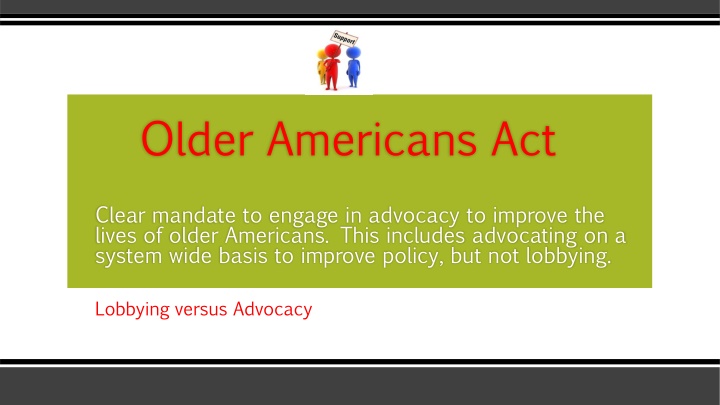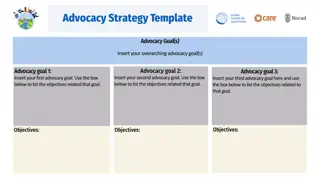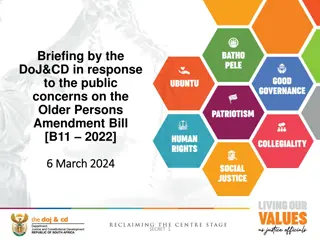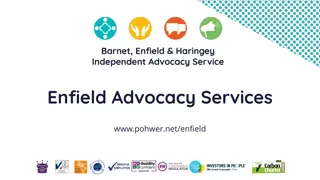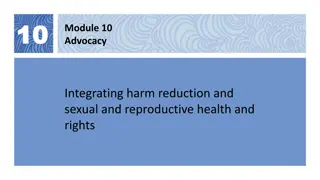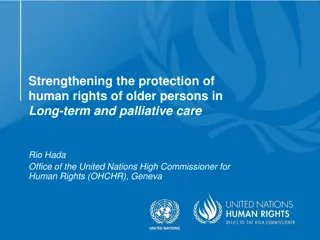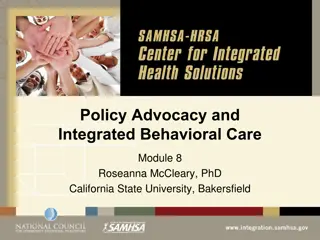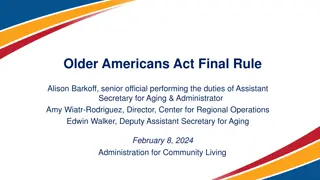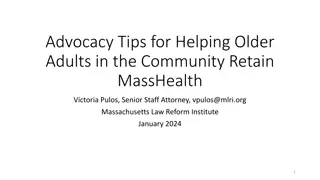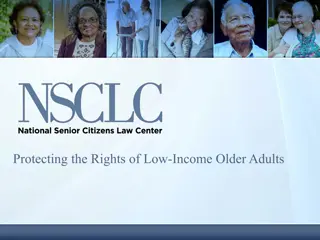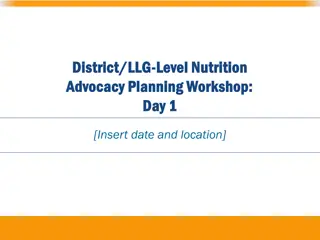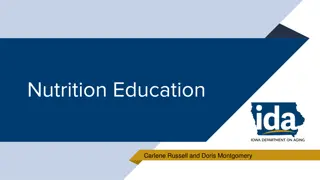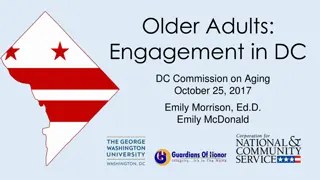Older Americans Act: Advocacy for Policy Improvement
The Older Americans Act emphasizes engaging in advocacy to enhance the lives of older Americans without lobbying. Learn the distinctions between lobbying and advocacy, examples of lobbying activities, different types of lobbying, and the broad scope of advocacy activities seeking policy influence and systemic change. Discover how individual and system-wide advocacy efforts make a positive impact on communities. Embrace the power of advocacy in promoting honesty, truth, compassion, and justice against injustice and greed.
Download Presentation

Please find below an Image/Link to download the presentation.
The content on the website is provided AS IS for your information and personal use only. It may not be sold, licensed, or shared on other websites without obtaining consent from the author.If you encounter any issues during the download, it is possible that the publisher has removed the file from their server.
You are allowed to download the files provided on this website for personal or commercial use, subject to the condition that they are used lawfully. All files are the property of their respective owners.
The content on the website is provided AS IS for your information and personal use only. It may not be sold, licensed, or shared on other websites without obtaining consent from the author.
E N D
Presentation Transcript
Older Americans Act Clear mandate to engage in advocacy to improve the lives of older Americans. This includes advocating on a system wide basis to improve policy, but not lobbying. Lobbying versus Advocacy
LOBBYING LOBBYING Lobbying means Lobbying means to try to influence government officials (particularly legislators) to make decisions for or against specific pieces of legislation or possible legislation. Lobbying versus Advocacy
Examples of Lobbying: (a) Asking your legislator to vote for or against, or amend legislation or asking your legislator to introduce legislation. (b) Preparing materials or organizing events in support of lobbying activities. Lobbying versus Advocacy
Different Types of Lobbying (a) Grassroots lobbying is appealing to the general public to contact the legislature to support or oppose specific legislation. Must include a call to action. (b) Direct lobbying is contacting legislators or their staff, or other government officials directly to support or oppose legislation. Lobbying versus Advocacy
ADVOCACY ADVOCACY Advocacy Advocacy is a broad term that covers a range of activities that seek to influence policies or bring about systemic social change. Advocacy often seeks to address the root causes, as well as the symptoms, of social and economic problems. Lobbying versus Advocacy
Examples of System Wide Advocacy: (a) Telling your legislator how a federal or state grant your organization received has helped older people in your community. (b) Educating a legislator about the impact of a policy on older adults. (c) Inviting a legislator to visit your organization so that she may see firsthand how a policy affects day-to-day operations and the difference it makes. Lobbying versus Advocacy
EBS Perform Advocacy Everyday EBS Perform Advocacy Everyday Individual advocacy is helping someone navigate a particular situation, whereas system wide or legislative advocacy is an ongoing process of working to improve the policies that affect those situations. Lobbying versus Advocacy
There is no limit to the amount of non-lobbying advocacy you can do. Never be afraid to raise your voice for honesty and truth and compassion against injustice and lying and greed. If people all over the world...would do this, it would change the earth. William Faulkner Lobbying versus Advocacy
CASE STUDY: CASE STUDY: Mary is an EBS for Great County in Northern Wisconsin. She gets a call from her legislative office of Great County asking for help with a problem of one of the constituent s of the legislative office. After she resolves the problem for the constituent, she calls the legislative office and tells them of her success in helping the constituent. When she calls the Wisconsin Legislature is considering proposed legislation that would significantly decrease funding for a program that she has used to help a number of seniors. Is it alright for Mary to mention her experience helping people under that program? Lobbying versus Advocacy
CASE STUDY: CASE STUDY: Bob is an EBS for Awesome County in Southern Wisconsin. She has heard about proposed legislation that will negatively impact seniors. She decides that she is going to write an editorial in her local newspaper and explain why this is such bad legislation. Is this lobbying? If this is lobbying, why is it lobbying? If this is not lobbying, what would have to be included in the editorial to make it lobbying? Lobbying versus Advocacy
CASE STUDY: CASE STUDY: Lisa has had a number of cases in which a state law has caused her to not be able to help seniors. She decides she needs to do something about this so she: (a) Invites her state legislator to her office so that the seniors can tell the state legislator the senior s story; (b) Provides the state legislator a recent study that documents the problem; (c) Provides the state legislator a news article that shows how Minnesota solved this problem by amending its state law; and, (d) Recommends that her state legislator should introduce similar legislation as to what they have in Minnesota. Which of these steps are permissible advocacy and which are lobbying? Lobbying versus Advocacy
CASE STUDY: CASE STUDY: John as part of his EBS duties makes a presentation at a monthly meeting of seniors. During the question and answer sessions, an audience member asks him about his opinion either for or against some specific pending legislation. Can John answer the question and not be considered to have lobbied on the legislation? If so, what does he need to be sure not to do? If not, what should he say? Lobbying versus Advocacy
CASE STUDY: CASE STUDY: Jane feels really passionate about the impact of a law that is up for renewal impacting older adults because she daily sees how it impacts her clients and knows the positive influence that it has personally had on her mother. She knows GWAAR has supported the laws renewal, but wants to do more than continue to educate legislators on the laws positive influence on older adults and wants to recommend changes to a number of state senators to some aspects of the legislation to make it even better. Is there anything else she can do? Lobbying versus Advocacy
CASE STUDY: CASE STUDY: Jane feels really passionate about the impact of a law that is up for renewal impacting older adults because she daily sees how it impacts her clients and knows the positive influence that it has personally had on her mother. She knows GWAAR has supported the laws renewal, but wants to do more than continue to educate legislators on the laws positive influence on older adults and wants to recommend changes to a number of state senators to some aspects of the legislation to make it even better. Is there anything else she can do? Lobbying versus Advocacy
